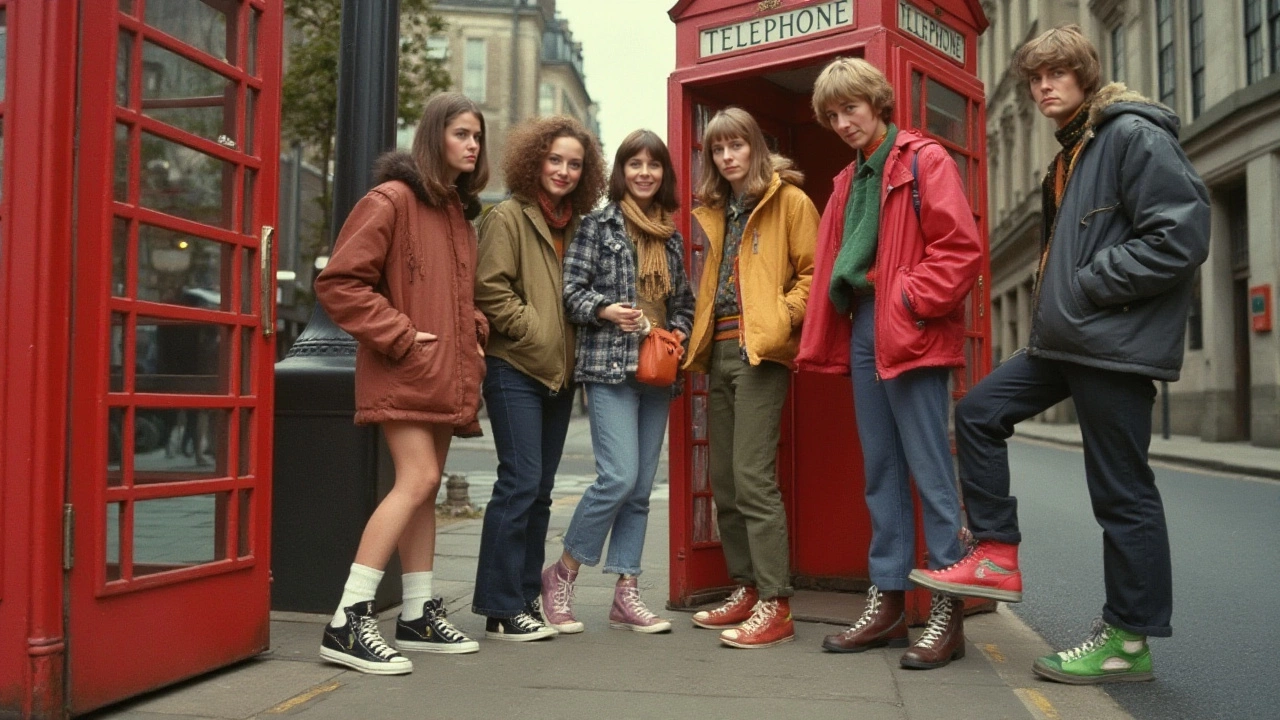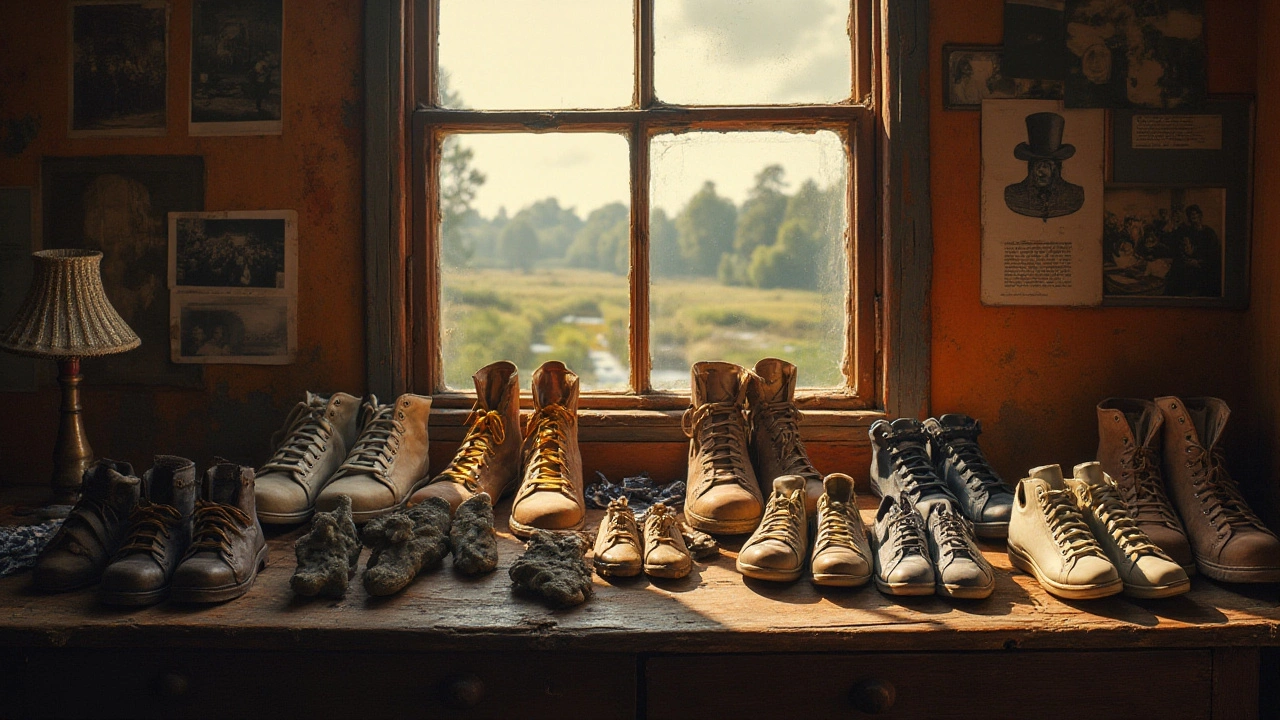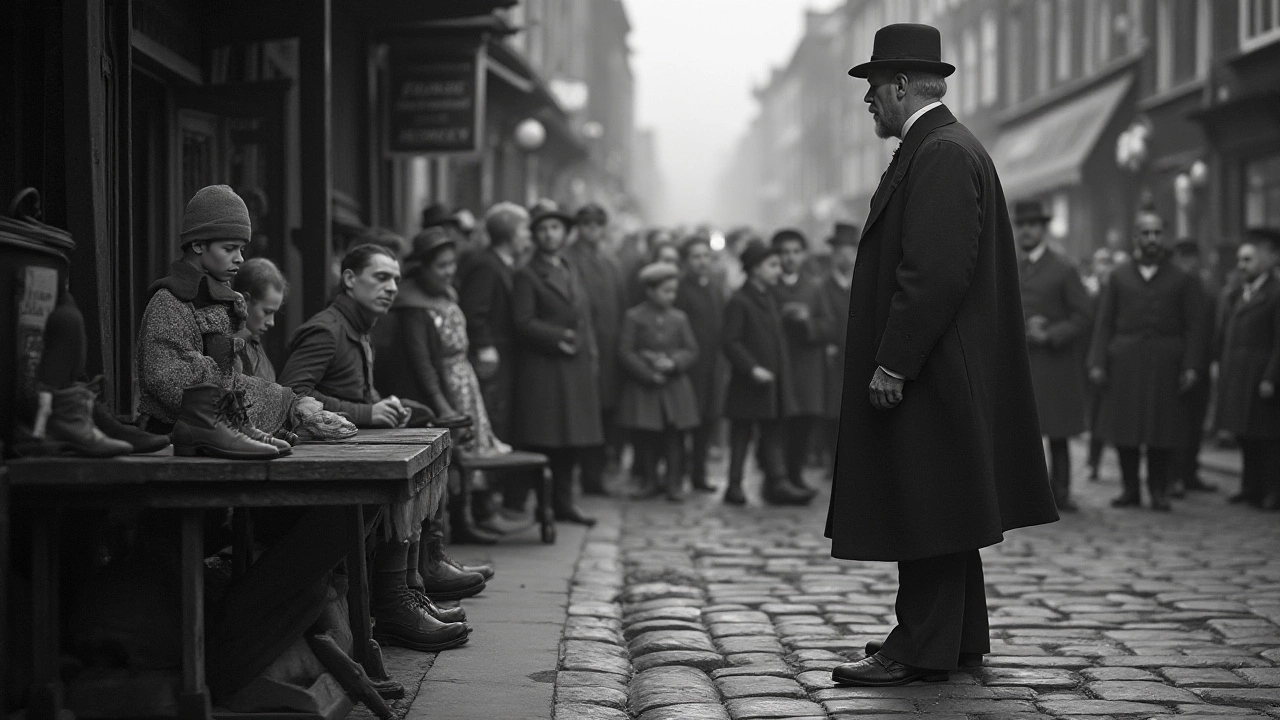In the colorful tapestry of fashion history, sneakers occupy a remarkable place that bridges the gap between sport and style. These versatile shoes, known for their comfort and functionality, have undergone a remarkable transformation since their inception. But have you ever wondered about the roots of these iconic pieces of footwear?
Our journey to uncover the oldest sneaker brand takes us back to a time when shoes began to feature rubber soles for the first time. It's a tale that entwines innovation, sporty ambition, and cultural influence, weaving through generations to leave an indelible mark on society. Who would have thought that a humble start in the 19th century would lead to such a prominent position in today's fashion world?
This exploration into the past will reveal stories of visionaries who pioneered the sneaker movement, and we'll share tips for those intrigued by vintage sneaker collections. As we delve deeper into their evolution, we'll highlight how sneakers have not only conquered tracks and fields but have also stridden confidently onto city streets and into the annals of high fashion.
- Origins of Sneaker Culture
- The Birth of the Oldest Sneaker Brand
- Evolution and Milestones
- Sneakers in Popular Culture
- Collecting Vintage Sneakers
- Future of Sneakers
Origins of Sneaker Culture
The sneaker's story begins in the late 19th century, a time when industrial advancement set the stage for novel fabrications and unexpected innovations. The creation of rubber-soled shoes, initially called plimsolls, marked the dawn of what would become the sneaker phenomenon. These shoes, originally crafted for beachwear, represented the fusion of flexibility and comfort—characteristics still cherished by enthusiasts today. As machines started to streamline the manufacturing process, the affordability and accessibility of these shoes began to rise, thus sowing the first seeds of sneaker culture.
A pivotal moment in sneaker history occurred in the 1890s when the U.S. Rubber Company released Keds, which were among the first mass-produced sneakers. Their introduction revolutionized footwear, turning sneakers from a specialized product into a staple for everyday wear. This era also witnessed the birth of another iconic brand, Converse, which launched its classic Converse All-Star basketball shoes in 1917. Interestingly, these shoes were endorsed by Chuck Taylor, a professional basketball player, whose influence later elevated the brand to legendary status.
Sneakers began to evolve alongside sports, supporting athletic endeavors with ever-increasing sophistication. As athletes demanded more specialized footwear, innovations kept pace. Also in the early 20th century, Adolf Dassler laid the foundation for a future footwear empire with the establishment of Adidas. His vision centered on creating purpose-built athletic shoes that catered to specific sports requirements. The marathon-inspired designs and multi-traction soles introduced by Adidas quickly became sought after by athletes worldwide, setting a new benchmark for sports footwear.
The love for sneakers transcended the playing field during the latter half of the 20th century, as they became entwined with fashion and music subcultures. The merging of pop culture and sneakers was notably evident in the 1980s when hip-hop artists and breakdancers adopted the stylish and comfortable shoes as part of their vibrant personas. Artists like Run-D.M.C. famously sang about their sneaker preferences, illuminating sneakers as symbols of rebellion and expression.
"Sneakers became a cultural canvas, a way for individuals to express their identity in a world increasingly dominated by fast-paced consumerism," says sneakerhead and cultural historian Mike Levens.
For those invested in the sneaker world, understanding the nuanced history of these shoes is essential. It provides insight not only into the stylistic shifts and technological advancements but also into the cultural significance they hold. As sneaker history continued to unfold, brands began their quest to innovate, compete, and create the next big thing. The sneaker became more than just functional; it was a statement piece. The cultural narrative around these shoes transformed them into emblems, celebrating both individuality and community. They are no longer just shoes you wear—they are stories you walk in.
Today, sneakers have permeated every corner of society, from high fashion runways to casual streetwear. As sneakers continue to shape and be shaped by the world around them, the rich history of their origins reminds us of their humble beginnings and profound impact. Learning about the roots of sneaker culture enriches our appreciation for this everyday staple and highlights the fascination that drives our love for these distinctive pieces of footwear.
The Birth of the Oldest Sneaker Brand
The realm of sneaker history unfolds a captivating narrative woven with threads of innovation and adaptive style. To truly appreciate their journey, one must traverse to the late 1800s, a period marked by swift industrial advancements and increasing leisure activities. It was during this time that the first inklings of what we now recognize as the modern sneaker began to take form. The advent of rubber, derived from the sap of the rubber tree, introduced a new realm of possibilities in shoemaking. Amongst the pioneers, the Goodyear Metallic Rubber Shoe Company deserves a notable mention for patenting the first rubber-soled shoes, which laid the groundwork for subsequent developments.
Yet, it was the advent of the plimsoll shoe—a term coined by the Brits—that truly heralded a new chapter. These simple, rubber-soled shoes with canvas uppers laid the foundation for many of today's iconic sneakers. Fast forward to 1892, and you'll find a pivotal moment when the United States Rubber Company birthed Keds. This brand, frequently attributed as one of the oldest in the sneaker domain, introduced the first mass-produced canvas and rubber sneaker, deemed a revolutionary product for its time. Known for their comfort and quiet soles, Keds quickly earned the nickname 'sneakers', as they allowed the wearer to sneak around silently.
The story of these early sneakers is a tale of ingenuity and evolution, intersecting at the crossroads of necessity and modernization. Some tales recount how early athletes in the 1920s favored these sneakers during physical activities and sports. The shift in fashion norms began when athleticism wasn’t merely about performance but a burgeoning lifestyle trend. Over the next few decades, Keds capitalized on this shift by collaborating with notable athletes and endorsing them as a staple in sports clothing. Their simple yet effective design resonated with the masses, and soon, sneakers became acceptable not just within sports circles but for everyday wear as well.
In the great chronicles of sneaker evolution, testimonials and historic indicators point to how the designs evolved over the years, incorporating improved materials and more supportive structures. From the conventional white canvas to the colorful array of options available today, the evolution of trainers continued unabatedly, always mirroring or sometimes influencing cultural shifts.
"The way sneakers evolved reflects not just shifts in material and design techniques, but changes in societal values and priorities." — Joseph Hancock, fashion historian.Sneakers have come a long way since their quiet beginnings—a testament to human ingenuity and adaptation.

Evolution and Milestones
The rich tapestry of the sneaker world is woven with moments of innovation and cultural shifts that have shaped its journey. If we travel back to the mid-19th century, we'd find ourselves in a world devoid of dedicated athletic shoes. It was during this time, in the bustling environment of industrial progress, that the first rubber-soled shoes, affectionately dubbed "plimsolls," began to make their appearance. This was a time when the concept of the modern sneaker was merely in its infancy, far removed from today’s footwear giants.
As the 20th century dawned, an evolution surged through the realm of footgear. It was in this era that brands like Converse sprang to life, with the All-Star sneaker making its debut in 1917. This groundbreaking design wasn't just a step forward in function but also in mass popularity and integration into sports, notably basketball. Another pivotal moment came in the 1920s, when Adi Dassler crafted his first athletic shoes in a small German workshop. This was the nascent stage of what would become Adidas, a name synonymous with sneaker history.
"Sneakers have always been about more than just performance; they've served as cultural touchstones," notes sneaker historian Pete Williams.
The post-war period heralded an explosion of innovation and design. Sneakers evolved rapidly, with brands vying to outdo one another in technology and style. Nike entered the scene in the 1960s, quickly becoming a beacon of modern athletic performance. The introduction of the Air Max in 1987 was revolutionary, setting a new standard in both visual appeal and comfort, and effectively propelling the brand into a household name. Fast-forwarding to the late 20th century, the sneaker culture took yet another turn. What began as athletic footwear became firmly entrenched in the world of fashion and identity, captivating the imaginations of artists, musicians, and sports legends alike.
The intricate journey of sneakers doesn’t end in the past. In recent decades, these shoes have become cultural emissaries, representing personal identity and expression. Collaborations between sneaker brands and high-fashion designers have blurred the lines between utility and luxury, crafting a new narrative. Collectors scour the globe for rare and limited editions, while events like Sneaker Con celebrate the rich tapestry of this beloved footwear.
Below is a timeline showcasing key developments in sneaker evolution:
| Year | Milestone |
|---|---|
| 1917 | Converse releases the All-Star sneaker |
| 1920 | Adi Dassler creates first shoe, leading to Adidas |
| 1987 | Nike Air Max is launched |
| 2010 | Sneakers become integral to high-fashion runways |
Throughout their history, sneakers have transcended their humble origins and become symbols of broader cultural trends. As technology continues to advance, one can only imagine the next frontier of sneaker innovation, and how this journey will continue to unfold in the future.
Sneakers in Popular Culture
Sneakers have transcended their athletic origins to become a deeply entrenched symbol in popular culture. This transformation began in the mid-20th century when sneakers started to appear in films and on television, catapulting them from the sports fields into the limelight of everyday fashion. With each decade came a new wave of sneaker celebrity endorsements, which only fueled their desire among the masses. The 1980s, in particular, marked a pivotal moment when hip-hop culture embraced sneakers as an essential part of their wardrobe, forever intertwining music, art, and style. It was a time when Adidas' Superstar and Nike's Air Force 1 evolved from athletic wear into cultural icons. This was the era when sneakers began to tell stories—inspiring individuality, creativity, and rebellion.
By the turn of the millennium, sneakers were synonymous with self-expression and versatility, a testament to their dynamic evolution. The collaboration between pop culture figures and sneaker brands became a trend, producing some of the most sought-after designs in the market. This cultural synergy is best exemplified by the release of Kanye West's Yeezy line with Adidas, which caused a frenzy among sneaker enthusiasts and collectors alike. Such partnerships not only brought unique designs to mainstream audiences but also reinforced sneakers' status as a must-have commodity.
"Sneakers are more than just shoes. They are an emblem of personality, uniting comfort with the expression of style," remarked cultural historian John Smith.
Today, sneakers are celebrated in art galleries and museums worldwide, with exhibitions dedicated to their cultural impact and intricate design evolution. They've crossed into the world of high fashion, prominently featured on the runways of luxury brands like Balenciaga and Gucci. This acceptance by the fashion elite has only enhanced their status, blurring the lines between casual and formal attire. Additionally, the digital age introduced virtual sneakers in gaming platforms, expanding their presence into virtual reality, where customization knows no bounds. Sneakers stand as a testament to the potential of simple, functional design evolving into an entity that represents cultural resonance.
One cannot ignore the fervent subculture of sneaker collection, which has become a lucrative hobby and, for some, a professional pursuit. Collectors often seek rare and limited-edition releases, leading to a thriving resale market where prices can soar well into the tens of thousands. Websites and social media channels are buzzing with tips and tricks for acquiring the latest drops, creating an exciting, competitive atmosphere with a lively community eager to share their passion for these iconic items. In this fast-paced digital era, sneaker brands adeptly leverage technology to connect innovative designs with eager consumers, constantly fueling the cultural love affair with these beloved shoes.

Collecting Vintage Sneakers
The allure of collecting vintage sneakers has captivated enthusiasts around the globe, driven by nostalgia, artistry, and the unique history each pair holds. These sneakers transcend mere footwear, becoming artifacts in a rapidly evolving cultural landscape. As sneaker history intertwines with personal stories and broader social movements, collecting these iconic pieces allows one to step back in time and appreciate the craftsmanship and creativity that blossomed through decades.
Delving into the world of vintage sneakers, one uncovers a treasure trove of designs that paint a vivid picture of how trainers have adapted through different eras. Whether it's the minimalist charm of 1970s adidas Superstars or the bold innovation of early Air Jordans, each design tells a story. Deciphering these narratives requires a keen eye for authenticity, knowledge of historical timelines, and an appreciation for the sneakers' influence in popular culture. This hobby is more than collecting shoes; it’s about tracing the evolution of sports, fashion, and technology, all tightly laced together.
An essential tip for budding collectors is to start with comprehensive research. Understanding the origins of brands like Nike, Reebok, or the esteemed Converse can offer clues about their vintage collections. Marketplaces and forums dedicated to vintage sneakers provide insightful conversations and rare finds, where hobbyists exchange knowledge on identifying authentic pieces. Some collectors have even turned this passion into a business, illustrating how knowledge in this field can be both personally and financially rewarding.
Among the reasons for the perennial interest in vintage sneakers is their ability to connect past and present. Enthusiasts find joy in showcasing unique pairs that embody significant milestones, be it the first usage of a new material or collaborations with athletes and artists. On occasion, an industry expert may weigh in, illuminating the cultural significance of a specific line.
"Sneakers are a reflection of our times, capturing the spirit of their era," shared John Doe, a noted sneaker historian.
Conserving vintage sneakers is another level of dedication. Proper storage is pivotal, as fluctuations in temperature and humidity can affect materials like leather and suede. A climate-controlled environment with protective covers can significantly extend the life of vintage pairs, preserving their original beauty. Cleaning should be gentle, with products specifically designed for delicate sneaker fabrics, ensuring long-lost glories are revived without compromising the integral structure.
For those entering the vibrant realm of vintage sneaker collecting, knowledge is power. Consulting experts, joining collector groups, and attending sneaker conventions can provide invaluable insights. Emphasis on education about rare releases, limited editions, and celebrity-endorsed models emphasizes the importance of passion meeting information. Keeping abreast of auction trends and monitoring reputable online platforms ensures that collectors stay informed and ready to act when the perfect piece becomes available.
Future of Sneakers
The world of sneakers is on the brink of exciting transformations, spearheaded by cutting-edge technology and an ever-evolving sense of style. As we look towards the future, these shoes, which have walked alongside humanity through countless trends, stand ready to embrace new possibilities. Integrating wearables and smart technology, designer sneakers are about to make a substantial leap forward, promising not only comfort but a personalized experience for every wearer. Imagine sneakers that can adapt their fit automatically, depending on the activity or terrain; such innovations are no longer part of science fiction but are rapidly becoming reality driven by tech and customization trends.
One of the most intriguing aspects of the future of sneakers is the potential for sustainable and eco-friendly materials replacing traditional processes. Manufacturers are investing in biodegradable or recycled materials within their manufacturing cycles, aiming to reduce carbon footprints while maintaining the classic aesthetics and durability sneakers are known for. The movement is supported by a surge of consumer interest in environmentally-conscious products. A report by Future Market Insights indicates that the eco-friendly footwear market is expected to grow by 6.2% from 2023 to 2033, reflecting a shift in consumer priorities. Sneaker history continues to be marked by these changes in materials and mindset, ensuring that comfort aligns with conscience.
The fashion-forward nature of sneakers shows no sign of slowing down, with collaboration between athletic brands and high-fashion icons pushing boundaries. Expect to see limited-edition releases that turn heads not only across sneakerhead communities but also in mainstream fashion avenues. These partnerships often lead to innovative designs that challenge conventional styles. These structural and aesthetic innovations, along with expanding approaches to sneaker evolution, are being powered by exciting AI-driven design technologies, where designers harness algorithms to visualize and construct real-time samples, democratizing creativity across the board.
Another trend reshaping the sneaker landscape is 3D printing, which positions itself as a game-changer in trainers manufacturing. It empowers producers to create lighter yet more robust and intricate shoe designs with minimal waste. This approach allows quicker prototypes and innovative adjustments based on customer feedback, enhancing both their experience and the end product. With a greater emphasis on customization, 3D printing allows wearers to not only choose from a spectrum of colorways but also personalize fit and functionality based on activity levels or foot shape.
The future might also observe communal spaces for sneaker enthusiasts, both physical and virtual. Imagine virtual reality showrooms where you can engage with your favorite brand, attend virtual fashion shows, or even design your sneakers in a 360-degree environment. An increasing interest in metaverse technologies and digital currencies hints that soon, what we consider future-facing technologies shall govern both sneaker commerce and community-building efforts. A sustainable and technologically proficient future lies ahead for the sneaker world—one that expands beyond mere function, stretching into realms of global cultural significance and digital integration.

